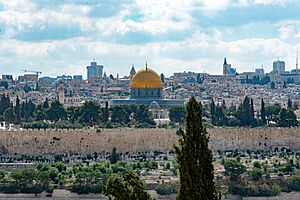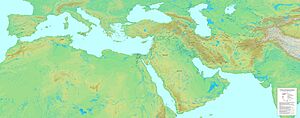Al-Maqdisi facts for kids
Quick facts for kids
Muḥammad ibn Aḥmad Shams al-Dīn Al-Maqdisī
مُحَمَّد ابْن أَحْمَد شَمْس ٱلدِّيْن ٱلْمَقْدِسِي |
|
|---|---|
| Born | c. 945/946 CE |
| Died | 991 CE |
| Academic background | |
| Influences | Al-Balkhi |
| Academic work | |
| Era | Islamic Golden Age |
| School or tradition | Balkhi school |
| Main interests | Islamic geography |
| Notable works | The Best Divisions in the Knowledge of the Regions |
Shams al-Din Abu Abd Allah Muhammad ibn Ahmad ibn Abi Bakr (born around 945/946 CE, died 991 CE) was a famous Arab geographer from medieval Palestine. He is better known as al-Maqdisi, which means "from Jerusalem". He wrote an important book called Aḥsan al-taqāsīm fī maʿrifat al-aqālīm, which translates to The Best Divisions in the Knowledge of the Regions.
Al-Maqdisi was one of the first people in history to call himself a Palestinian during his travels.
Contents
Biography
How We Know About Him
We don't have many details about al-Maqdisi's life from other writers. Most of what we know comes from his own books. Other famous biographers of his time did not write much about him.
His Early Life and Learning

Al-Maqdisi was born in Jerusalem around 946 CE. His family was middle-class and had lived in the Jerusalem area for a long time. The name al-Maqdisi means "from Bayt al-Maqdis," which is an old Muslim name for Jerusalem. He loved his hometown very much.
His family had a history of building. His grandfather, Abu Bakr al-Banna, helped build the sea defenses of Acre. This was done for Ahmad ibn Tulun, who governed Egypt and Syria. Al-Maqdisi's other grandfather, Abu Tayyib al-Shawwa, was also an architect. He moved to Jerusalem from a place called Biyar in Khurasan.
Because of his writings, we know al-Maqdisi was very well-educated. He knew a lot about Arabic grammar and literature. He also showed an early interest in Islamic law, history, language studies, and hadith (sayings of the Prophet Muhammad).
His Journeys for Geography
In 967 CE, al-Maqdisi went on his first Hajj (pilgrimage to Mecca). During this trip, he decided to dedicate his life to studying geography. To gather information, he traveled throughout the Islamic world. He visited almost all its lands, except for Spain (al-Andalus), Sindh, and Sistan.
We know he visited Aleppo between 965 and 974 CE. He went on his second pilgrimage to Mecca in 978 CE. In 984 CE, he visited Khurasan. He stayed in Shiraz in 985 CE, where he decided to write down all his findings. His finished book was called Aḥsan al-taqāsīm fi maʾarfat al-aqalīm, or The Best Divisions for the Knowledge of the Provinces.
His Work
Al-Maqdisi was influenced by earlier geographers like al-Jahiz. However, he went further and created what is considered a true geography. He believed that geography was its own unique science. He was part of a group of geographers known for creating an "atlas of Islam." This group included Abu Zayd al-Balkhi and Ibn Hawqal.
Al-Maqdisi's studies focused only on the Islamic world. He called this world al-mamlaka or al-Islām, meaning the "Domain of Islam." He saw all Islamic lands as one single area. He then divided this domain into two main parts:
- mamlakat al-ʿArab (the domain of the Arabs)
- mamlakat al-ʿAjam (the domain of the non-Arabs)
The Arab domain included six provinces from east to west: Iraq, Upper Mesopotamia, Arabia, Syria, Egypt, and the Maghreb. The non-Arab domain had eight provinces, including places like Khurasan, Sindh, and Armenia.
Describing Palestine
His book Aḥsan al-taqāsīm gives a detailed account of all the places he visited. He wrote a special section about Bilad al-Sham (the Levant), focusing on Palestine. Unlike many travelers who were pilgrims, al-Maqdisi gave deep insights into the region. He described the people, their way of life, the economy, and the climate.
He paid special attention to Jerusalem, his hometown. He described its layout, walls, streets, markets, and important buildings. He especially focused on the Haram ash-Sharif (Temple Mount), including the Dome of the Rock and the Jami Al-Aqsa. He wrote about the people and customs of Jerusalem, focusing on Muslims but also mentioning the Christian and Jewish communities.
Al-Maqdisi also gave detailed descriptions of Ramla and Tiberias. These were important cities and capitals of their districts. He also mentioned other cities like Acre, Beisan, and Amman. In his descriptions, he noted that these cities were doing well and were stable. He gave the impression that Palestine was a wealthy region with many towns and a large population.
The historian Guy Le Strange said that al-Maqdisi's description of Palestine, especially Jerusalem, was one of the best parts of his work. He noted that everything al-Maqdisi wrote came from his own observations. His descriptions of customs showed he was very smart and observant.
Describing Eastern Arabia
Al-Maqdisi also wrote about regions in Eastern Arabia. These areas are now part of Saudi Arabia, the UAE, and Oman. He mentioned:
- Al-Hasa: An important oasis region in eastern Saudi Arabia.
- Tuwwam: Another oasis region split between the UAE and Oman. This area includes the modern cities of Al Ain and Al-Buraimi.
- Dibba: A region also split between the UAE and Oman, near the Musandam Peninsula.
- Julfar: An ancient settlement located in the Emirate of Ras Al Khaimah.
See also
- List of Arab scientists and scholars
- Zedekiah's Cave


